
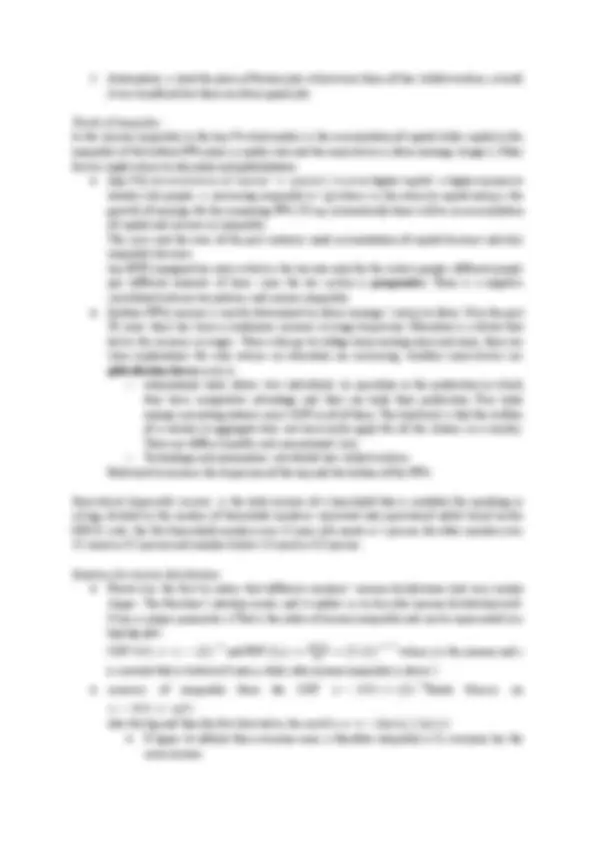
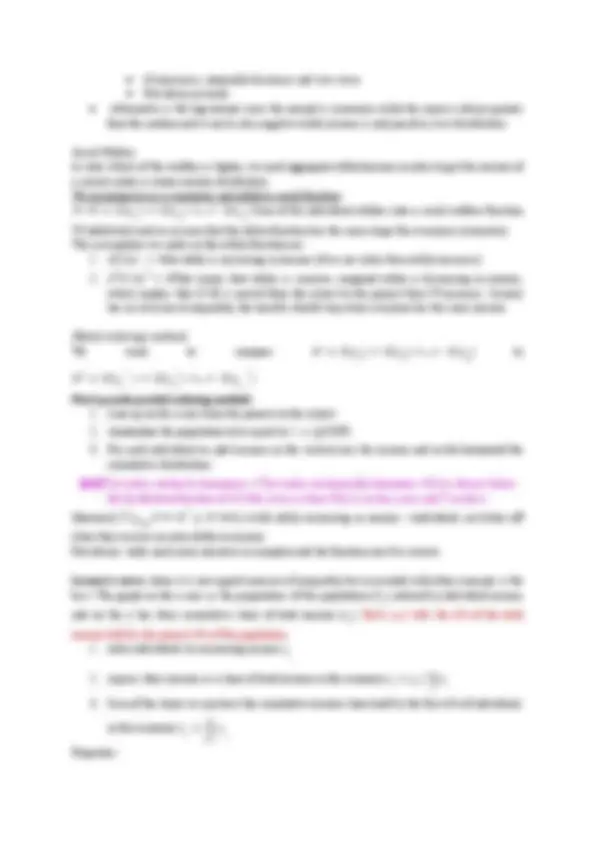
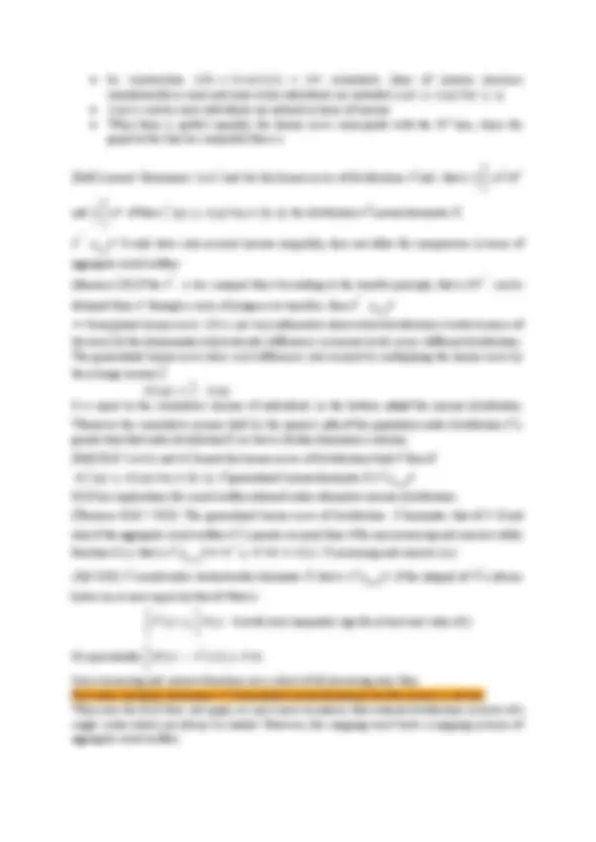
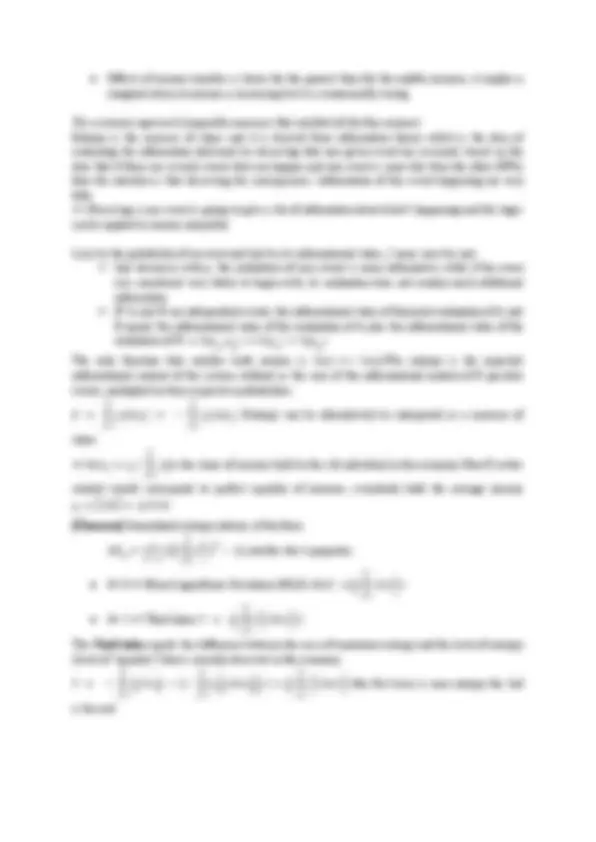
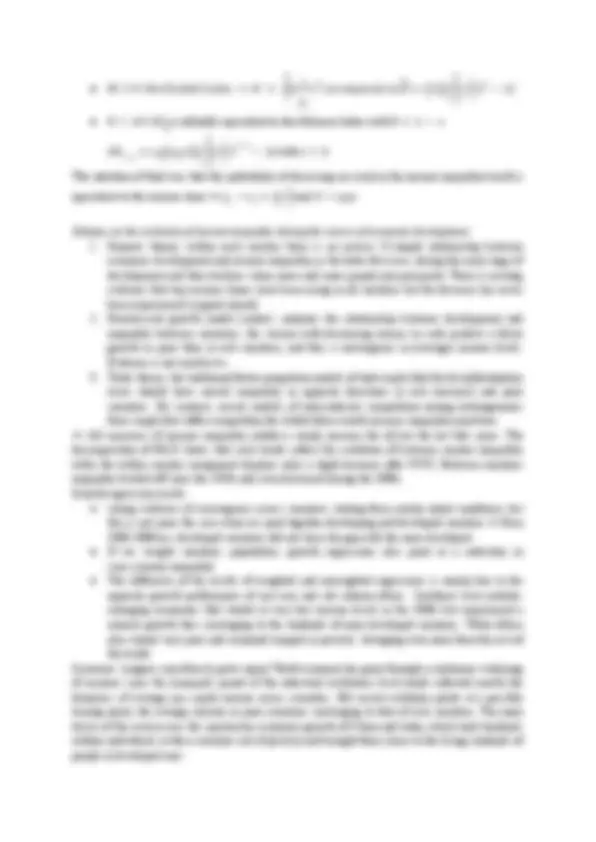
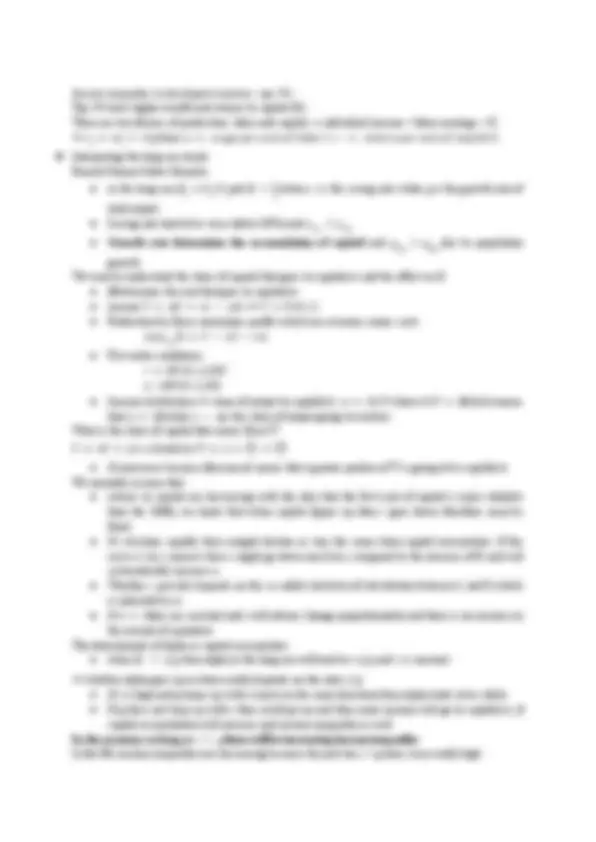
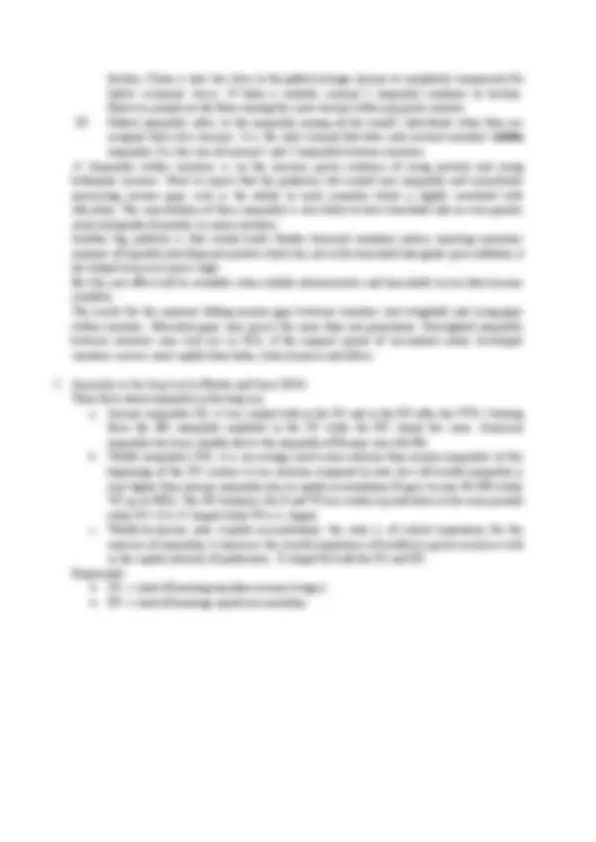


Study with the several resources on Docsity

Earn points by helping other students or get them with a premium plan


Prepare for your exams
Study with the several resources on Docsity

Earn points to download
Earn points by helping other students or get them with a premium plan
Community
Ask the community for help and clear up your study doubts
Discover the best universities in your country according to Docsity users
Free resources
Download our free guides on studying techniques, anxiety management strategies, and thesis advice from Docsity tutors
The concept of income distribution and its relationship with inequality, both within and between countries. It explores the reasons for analyzing inequality and poverty using solid criteria, such as simplification and the ability to compare different measures. The document also covers various methods for evaluating income inequality, including complete ordering methods and social welfare functions. Additionally, it touches upon the relationship between income inequality and economic factors like financial instability, political polarization, and automation.
What you will learn
Typology: Summaries
1 / 13

This page cannot be seen from the preview
Don't miss anything!








( Higher the gini higher the inequality) Summary ECONOMICS Inequality and poverty are a major source of conflict, both within and between societies and there are in principle many ways to conduct comparisons, it is crucial to agree on a set of criteria to assess such phenomena. One common measure of inequality measures it by the share of total income held by the wealthiest x% of the population. Income inequality is based on the income distribution of the whole population and it must be simplified. [def] Income distribution indicates for every level of income how many people have that amount of income. Represented in a graph (x: income (Y) and y: #people) , the integral of the income distribution represents the number of people with income below that amount. Income distribution → inequality → poverty ★ wage / earnings: salary from work, flow variable. ★ Income: is a flow variable and corresponds to all the resources generated in a period = wage + returns to capital ★ wealth: is a stock that is all that is owned at a given point in time, stock variable Wealth inequality is larger than income inequality due to accumulation, wealth is “transmitted” in time. The need for criteria:
1. Pigou-Dalton transfer principle: an income transfer from a richer to a poorer individual (which does not reverse the ranking of the two) reduces inequality; conversely, a transfer from a poorer to a richer country increases inequality ⇒ progressive transfers reduce inequality. Regressive transfer (transfer from a poorer to a richer individual) increases inequality. In the last two decades inequality increased considerably both in developed and developing countries, based on the share of income held by the richest 10% of the world which is a measure that is available for several countries over long periods of time. Within inequality has for sure risen, but inequality between countries has fallen and the average income of some developing countries is now closer to that of developed countries. The evolution of total income depends on which of these two opposite effects prevails. Even if inequality increased in most of the countries the global inequality has been decreasing. Such an argument does not survive a closer scrutiny, as the global distribution of income depends not only on the dispersion of income around the average income within each country, but also on the dispersion of avg income between countries. Within equality rises, but inequality between countries falls, because the average income of some developing countries is now closer to that of developed countries: the evolution of total inequality thus depends on which of these two opposite effects prevails
Inequality: to evaluate the inequality of income distribution, one may use partial or complete ordering methods. ● partial methods: compare distributions over the whole range of incomes. Whenever distributions can be ranked in this way, such ranking will be valid under very general assumptions about individual preferences and social welfare. Rarely possible to form such a ranking. The pro is that it is valid under very general assumptions, it has an intuitive graphical representation however, it is useless in most practical applications. ● Complete ordering methods: collapse the complexity of income distribution to a simple, scalar index: since scalars can always be ranked, income distributions can always be ranked. Pros: allow you to answer more practical questions but they require stronger assumptions, sometimes not very intuitive. ○ Ad hoc measures: derived from graphical methods (gini, pareto) and/or adapted from standard statistical methods(variance, coeff of variation). Not grounded into economic theory, so the ranking may conflict with economic intuition and the rationale behind such methods is not very transparent. ○ Welfare based methods (atkinson index): grounded into the utility function, nice theoretical interpretation. The certaint equivalent allows us to assess not only whether one distribution is more or less unequal than another one, but also whether it is better or worse in general, conditional on some parametrization of the utility function. Such parameters make the criteria used for the comparison very transparent, it is not decomposable. ○ Entropy measures (mean logarithmic deviation) Poverty: the main difference between poverty and inequality measures is that the former focus just on poor people, defined as those with income below a given poverty line. Axiom that be satisfied in any poverty measure ● absolute poverty line: fixed monetary amount ● relative poverty line: defined relative to income levels in the population From the lines it is possible to compute indexes. ● PPP = purchasing power parity is an exchange rate that is calculated by estimating how many $ are needed to buy the same exact basket of goods in different countries Three I’s of poverty (satisfy the transfer principle): ● Incidence: how many people are below the threshold ● intensity: how insensibly are the people below the threshold (less the better) ● Inequality of poverty: preferred to have as similar as possible incomes. Why should we care about inequality?
● if αincreases, inequality decreases and vice versa ● Not alway accurate ● Alternative is the log-normal since the normal is symmetric while the mean is always greater than the median and it can be also negative while income is only positive, best distribution Social Welfare to state which of the welfare is higher, we need aggregate utility/income in order to get the income of a society under a certain income distribution We are going to use a symmetric and additive social function ⇒ 𝑊 = 𝑈(𝑦 Sum of the individual utilities into a social welfare function 1
2
𝑛
W (additivity) and we assume that the utility function has the same shape for everyone (symmetry). The assumptions we make on the utility function are:
2
𝑛
= 𝑈(𝑦 1
) + 𝑈(𝑦 2
) +... + 𝑈(𝑦 𝑛
) Pen’s parade partial ordering method:
𝐹 the distribution function of 𝐹(𝑌)for every y where F(y) is on the y-axis and Y on the x [theorem] 𝐹 ⇒ with utility increasing in income individuals are better off
≥𝑆𝐷1𝐹 𝑊
≥ 𝑊 ∀𝑈(𝑦) ∼ when they receive an extra dollar in income Not always valid, need more narrower assumption and the function must be convex Lorenz’s curve: alone it is not a good measure of inequality, but associated with other concepts is the best. The graph on the x-axis as the proportions of the population ( 𝐹𝑖), ordered by individual income and on the y has their cumulative share of total income ( 𝐿). Each (x,y) tells the y% of the total 𝑖 income held by the poorest x% of the population.
𝑗= 𝑖 ∑ 𝑠 𝑗 Properties:
● by construction 𝐿(0) = 0 𝑎𝑛𝑑 𝐿(1) = 1 ⇒ cumulative share of income increases monotonically as more and more richer individuals are included 𝐿(φ') ≥ 𝐿(φ) ∀φ' ≥ φ ● 𝐿(φ)is convex since individuals are ordered in terms of income ● When there is perfect equality, the lorenz curve corresponds with the 45° line, closer the graph to this line less inequality there is. [Def] Lorenz’s Dominance: Let 𝐿and be the lorenz curves of distributions and , that is
𝐿 𝐹
𝑑𝐹
and then the distribution Lorenz-dominates F, 1 𝑦 0 φ ∫ 𝑦𝐹 𝑑𝐹 𝐿
(φ) ≥ 𝐿(φ) ∀φ ∈ [0, 1], 𝐹
𝐹. It only takes into account income inequality, does not allow for comparisons in terms of
≥ 𝐿𝐷
aggregate social welfare [theorem LD] If the 𝐹 is less unequal than according to the transfer principle, that is if can be
𝐹 𝐹
obtained from 𝐹 through a series of progressive transfers, then𝐹
≥𝐿𝐷𝐹 ⇒ Generalized lorenz curve: LD is not very informative about which distribution is better because of the term 𝑦at the denominator which absorbs differences in income levels across different distributions. The generalized lorenz curve takes such differences into account by multiplying the lorenz curve by the average income 𝑦 𝐺𝐿(φ) = 𝑦 · 𝐿(φ) It is equal to the cumulative income of individuals in the bottom φ%of the income distribution. Whenever the cumulative income held by the poorest φ% of the population under distribution 𝐹is
greater than that under distribution F, we have a further dominance criterion: [Def] GLD: Let 𝐺𝐿 and 𝐺𝐿denote the lorenz curves of distributions and then if
𝐹 𝐹
𝐺𝐿 generalized Lorenz-dominates F,
(φ) ≥ 𝐺𝐿(φ) ∀φ ∈ [0, 1], 𝐹
𝐹
≥𝐺𝐿𝐷𝐹 GLD has implications for social welfare attained under alternative income distributions. [Theorem GLD / SD2]: The generalized lorenz curve of distribution 𝐹dominates that of if and
𝐹 only if the aggregate social welfare 𝑊is greater or equal than for any increasing and concave utility
𝑊 function 𝑈(𝑦) that is 𝐹 : U increasing and concave in y
≥ 𝐺𝐿𝐷
≥ 𝑊 ∀𝑈 ∈ 𝑈(𝑦) [Def SD2] 𝐹second-order stochastically dominates F, that is if the integral of is always
𝐹
≥𝑆𝐷2𝐹, 𝐹
below (or at most equal to) that of 𝐹that is with strict inequality sign for at least one value of y 0 𝑦 ∫ 𝐹
(𝑦) ≤ 0 𝑦 ∫ 𝐹(𝑦) ∀𝑦 Or equivalently 0 𝑦 ∫ [𝐹(𝑦) − 𝐹
(𝑦)] ≥ 0 ∀𝑦 Since increasing and concave functions are a subset of all increasing ones then First order stochastic dominance ⇒ Generalized Lorenz dominance but the reverse is not true When also the GLD does not apply, we must move to indexes that evaluate distributions in terms of a single scalar which can always be ranked. However, this mapping won’t have a mapping in terms of aggregate social welfare.
𝐺𝐼𝑁𝐼 = 𝑖=1 Given a population The Gini index equals the average difference in 𝑁 ∑ 𝑗= 𝑁
2𝑁^2 𝑦
income between all possible pairs of individuals in the population (i.e. expected difference between any two individuals picked at random) relative to the average income. The most popular formulation of the Gini is closely correlated with the Lorenz Curve. It is the ratio of the area between the lorenz curve and the 45° line, which represents perfect equality. 𝐴 + 𝐵 = 1 2 ⇒ 𝐺𝐼𝑁𝐼^ =^ 2𝐴 0 (𝑝𝑒𝑟𝑓𝑒𝑐𝑡 𝑒𝑞𝑢𝑎𝑙𝑖𝑡𝑦) ≤ 𝐺𝐼𝑁𝐼 ≤ 1(𝑚𝑎𝑥 𝑖𝑛𝑒𝑞𝑢𝑎𝑙𝑖𝑡𝑦) Formally 𝐺𝐼𝑁𝐼 = 1 − 1 𝑁^2 𝑦 𝑖= 𝑁 ∑ ( 𝑗= 𝑖 ∑ 𝑦 𝑖
𝑗= 𝑖− ∑ 𝑦 𝑖
Income scale invariance and population principle are satisfied. GINI is not a subgroup decomposable. It can be decomposed only to the extent that the income distribution of the various groups do not overlap, meaning that the top income of the poorer group is lower than the bottom income of the richer group → hardly realized Equivalent formulation: 𝐺𝐼𝑁𝐼 = The term in [] is the covariance between the 2 𝑁𝑦
𝑖= 𝑁 ∑ 𝑖·𝑦𝑖 𝑁 − 𝑖 · 𝑦] value and the ranking of individuals' incomes along the whole distribution. The interpretation is that income changes that correlate positively with the ranking - i.e. an increase (decrease) of higher (lower) incomes - raise inequality, and thus the Gini index; the opposite is true for income changes that are negatively correlated with the ranking. Going back to the transfer principle, a transfer 𝑑𝑦 from R to P, with 𝑦 implies that 𝑃
𝑅 𝑑𝐺𝐼𝑁𝐼 =− [ so the transfer principle is satisfied. A decrease in the index is 𝑅−𝑃 2𝑁^2 𝑦
proportional to the number of individuals with income between P and R. A transfer between two individuals with relative income 𝑦𝑅/𝑦𝑃would change the index differentially depending on the height of the density between R and P: the more people there are with income between 𝑦𝑅 𝑎𝑛𝑑 𝑦𝑃, the greater will be the change in the index. Note: given the bell shape of income distributions, the effect of income transfers on inequality, as measured by the gini index, will be non-monotonic in income, increasing around the mean/median/mode and decreasing at both tails and distributions. This last property of the Gini (the fact that the effect of income transfers is lower for the poorest than for middle incomes) is due to the fact that the index is not grounded into economic principles, properties might contradict basic economic intuition. Negative aspects of the gini:
● Effects of income transfers is lower for the poorest then for the middle incomes, it implies a marginal return to income is increasing but it is economically wrong The axiomatic approach (inequality measures that satisfied all the four axioms) Entropy is the measure of chaos and it is derived from information theory which is the idea of evaluating the information delivered by observing that one given event has occurred, based on the idea that if there are several events that can happen and one event is more like then the other (99%) then the intuition is that observing the consequences /information of this event happening are very little ⇒ Observing a rare event is going to give a lot of information about what’s happening and this logic can be applied to income inequality Let p be the probability of an event and h(p) be its informational value, 2 axios must be met: ➢ h(p) decreases with p: the realization of rare events is more informative, while if the event was considered very likely to begin with, its realization does not contain much additional information ➢ IF A and B are independent events, the informational value of that joint realization of A and B equals the informational value of the realization of A plus the informational value of the realization of B → ℎ(𝑝 𝐴
𝐵
𝐴
𝐵
The only function that satisfies both axioms is ℎ(𝑝) =− 𝑙𝑛(𝑝)The entropy is the expected informational content of the system, defined as the sum of the informational content of N possible events, multiplied by their respective probabilities 𝐸 = Entropy can be alternatively be interpreted as a measure of 𝑖= 𝑁 ∑ 𝑝 𝑖
𝑖
𝑖= 𝑁 ∑ 𝑝 𝑖
𝑖
chaos ⇒ let 𝑝𝑖 = 𝑦𝑖 / be the share of income held by the i-th individual in the economy. Max E in this 𝑖= 𝑁 ∑ 𝑦𝑖 context would correspond to perfect equality of incomes, everybody hold the average income 𝑝. 𝑖
[Theorem] Generalized entropy indexes of the form 𝐺𝐸θ = satisfies the 4 properties 1 θ^2 −θ
1 𝑁 𝑖= 𝑁 ∑ ( 𝑦𝑖 𝑦
θ − 1] ● θ= 0 ⇒ Mean Logarithmic Deviation (MLD)𝑀𝐿𝐷 = 1 𝑁 𝑖= 𝑁 ∑ 𝑙𝑛( 𝑦 𝑦𝑖^ ) ● θ= 1 ⇒ Theil Index𝑇 = 1 𝑁 𝑖= 𝑁 ∑ ( 𝑦𝑖 𝑦
𝑦𝑖 𝑦
The Theil index equals the difference between the case of maximum entropy and the level of entropy (level of “equality”) that is actually observed in the economy 𝑇 = − the first term is max entropy the 2nd 𝑖= 𝑁 ∑ 1 𝑁 𝑙𝑛^ 1 𝑁 − [−^ 𝑖= 𝑁 ∑ ( 𝑦𝑖 𝑁𝑦
𝑦𝑖 𝑁𝑦
1 𝑁 𝑖= 𝑁 ∑ 𝑦𝑖 𝑦
𝑦𝑖 𝑦
is the real
Income inequality in developed countries: top 1% Top 1% have higher wealth and returns to capital (K) There are two factors of production: labor and capital → individual income = labor earnings + K ⇒ 𝑦𝑖 = 𝑤𝑙𝑖 + 𝑟𝑘𝑖where 𝑤 = 𝑤𝑎𝑔𝑒 𝑝𝑒𝑟 𝑢𝑛𝑖𝑡 𝑜𝑓 𝑙𝑎𝑏𝑜𝑟 𝑙, 𝑟 = 𝑟𝑒𝑡𝑢𝑟𝑛 𝑝𝑒𝑟 𝑢𝑛𝑖𝑡 𝑜𝑓 𝑐𝑎𝑝𝑖𝑡𝑎𝑙 𝑘 ★ Interpreting the long run trends Harrod-Domar-Solow formula: ● in the long run β and where s is the saving rate while g is the growth rate of 𝑡
𝑡
𝑡 β → 𝑠 𝑔 total output ● Saving rate tend to be very stable (10%) and 𝑠𝑈𝑆 < 𝑠𝐸𝑈 ● Growth rate determines the accumulation of capital and 𝑔 due to population 𝑈𝑆
𝐸𝑈 growth We want to understand the share of capital that goes to capitalists and the effect on II. ● βdetermines the rent that goes to capitalists ● income 𝑌 = α𝐾 + (1 − α)𝐿 ⇒𝑌 = 𝐹(𝐾, 𝐿) ● Production by firms maximizes profits which are revenues minus costs 𝑚𝑎𝑥𝐾,𝐿Π = 𝑌 − 𝑟𝐾 − 𝑤𝐿 ● First order conditions: 𝑟 = ∂𝐹(𝐾, 𝐿)/∂𝐾 𝑤 =∂𝐹(𝐾, 𝐿)/∂𝐿 ● Income distribution ⇒ share of output to capitalists α = 𝑟𝐾/𝑌 where 𝐾/𝑌 = βwhich means that α = 𝑟β while 1 − αis the share of output going to workers What is the share of capital that comes from Y? 𝑌 = 𝑟𝐾 + 𝑤𝐿 → divide by Y → 1 = 𝑟𝐾 𝑌 +^ 𝑤𝐿 𝑌 ● if αincreases because βincreased means that a greater portion of Y is going to be capitalists We normally assume that: ● returns to capital are decreasing with the idea that the first unit of capital is more valuable than the 100th, we know that when capital β goes up then r goes down therefore αcan be fixed ● If r declines rapidly then αmight decline or stay the same when capital accumulates. If the curve is less concave then r might go down much less compared to the increase of K and will systematically increase α ● Whether r prevails depends on the so called elasticity of substitution between L and K which is indicated by σ. ● if σ = 1then αis constant and r will always change proportionately and there is no increase in the reward of capitalists The determinants of alpha as capital accumulates: ● when β → 𝑠/𝑔 then alpha in the long run will tend to 𝑟𝑠/𝑔and s is constant ⇒ whether alpha goes up or down really depends on the ratio 𝑟/𝑔 ● if r is high and g keeps up with r (move in the same direction) then alpha tends to be stable ● If g does not keep up with r then αwill go up and then more income will go to capitalists, β capital accumulation will increase and income inequality as well In the economy as long as 𝑟 > 𝑔 there will be increasing income inequality In the 80s income inequality was decreasing because the post tax r < g taxes were really high
⇒ it is up to society to decide policies that prevent r from being much larger than g Taxation MTR: marginal taxation rate → highest income is applied to those with the highest income in the society. Higher taxes affect the marginal propensity to work meaning that higher taxes increase the disincentive to work which in turn will negatively affect GDP. Historically, countries that have decreased their MTR (US) saw an increase in top 1% of income inequality, while countries that kept MTR stable saw a little change in income inequality (FR, DEU) ⇒ MTR is a strong determinant of income inequality for top 1% Social welfare is larger when resources are more equally distributed, but redistributive taxes and transfers can negatively affect incentives to work ⇒ tradeoff equity / efficiency Taxation doesn’t only affect post-tax income but also the before tax one by affecting the incentive to work if the taxes are higher and before tax since the rich will try to hide the income if t is too high. Optimal labor income taxation - Piketty and Saez ❖ Scenario 1: no behavioral response: people will work the same amount of hours with and without taxes. Maximizing Wealth subject to the budget constraint with respect to 𝑇and it is 𝑖 equal to λthat is the government confiscates 100% of income and redistribute it into equal parts across all citizens ⇒ optimal tax rate is the 100% tax rate ❖ Scenario 2 behavioral responses: taxation diminishes labor supply. We need to consider: ➢ Importance of behavioral response: utility is individual specific and it is a decreasing function of earnings ➢ Trade off inequality/efficiency: pre tax earnings cost effort but indirectly they increase consumption ⇒ tradeoff ➢ Importance of political preferences: W is a weighted sum of individual’s utilities, government care more for some categories of individuals Taxation is linear and every individual is taxes at a single tax rate τand higher the tax rate less you are going to work since more income implies more consumption which includes leisures that implies that you work less. The curve that shows the τmaximizing the tax revenues for the government is the Laffer curve. Laffer curve ● y-axis: R for revenues ● x-axis: τfor tax rate Up to a level τthe revenues will increase
while after the revenues will start decreasing as people will stop working ★ To know the optimal taxation we need to calculate the labour supply elasticity e τ
= 1 1+𝑒 ★ Higher the elasticity ⇒ higher the response of earnings to ↑taxes ⇒ lower optimal taxation Adjusting we get: τ = 1−𝑔 1−𝑔+𝑒 Implications:
decline, China is now too close to the global average income to completely compensate for India's economic losses. If India is omitted, concept 2 inequality continues to decline. However, people are far from earning the same income within any given country. III. Global inequality refers to the inequality among all the world’s individuals when they are assigned their own incomes. It is the only concept that takes into account countries' within inequality. It is the sum of concept 1 and 2 inequality between countries. ⇒ Inequality within countries is on the increase, given evidence of rising poverty and rising billionaire incomes. Need to expect that the pandemic oth created new inequality and exacerbated preexisting income gaps such as the ability to work remotely which is highly correlated with education. The exacerbation of these inequality is also likely to have translated into an even greater racial and gender disparities in many countries. Another big problem is that central banks further loosened monetary policy, injecting enormous amounts of liquidity into financial markets which has not so far translated into goods price inflation, it has helped keep asset prices high. But the real effect will be available when reliable administrative and household survey data become available. The results for the moment: falling income gaps between countries (not weighted) and rising gaps within countries. Education gaps may persist for more than one generation. Unweighted inequality between countries may well rise in 2021, if the unequal spread of vaccination makes developed countries recover more rapidly than India, Latin America and Africa.